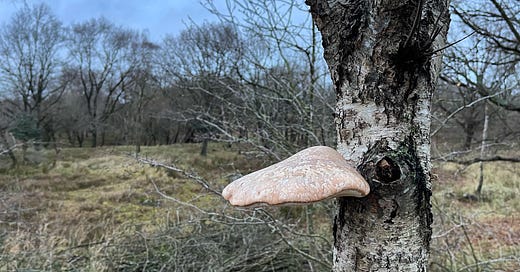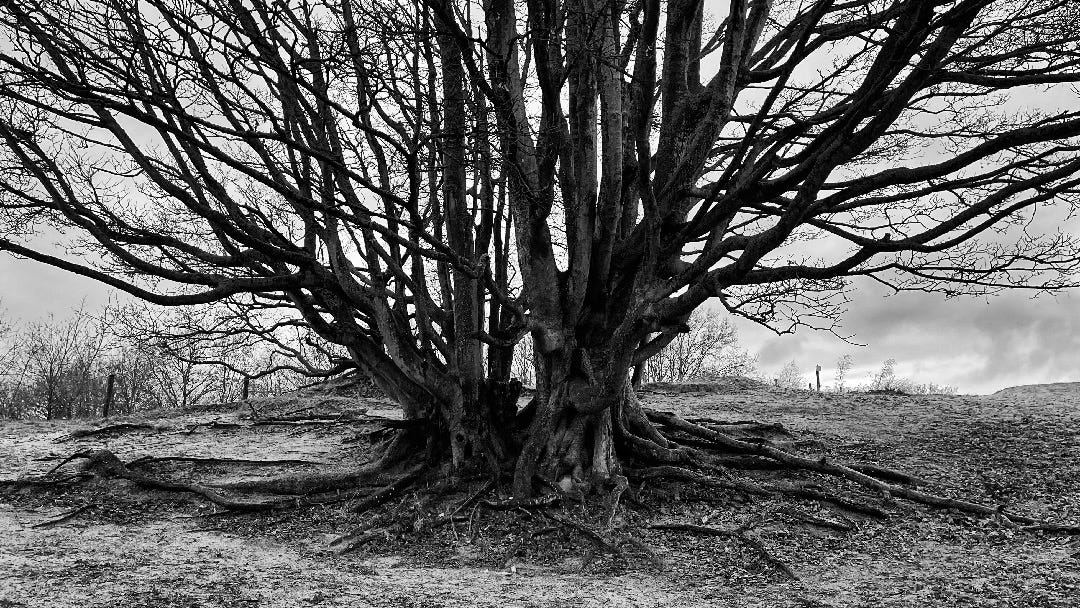The birch fungus that Ötzi the iceman found 5,300 years ago
And: check out the end of year discount for The Planet
A swampy, shady part of the dunes is risky to grow for a birch tree because it is likely to fall victim to a fungus that we call in Dutch "berkendoder," the birch killer. And that is the sad experience of this birch tree. I passed it today in the dunes, and I know the fungus wasn’t there when I was here during the dry summer.
Now, with the birch killer growing out of it, the tree won't survive; but it will keep standing for a while, first develop brown rot, and then lose some of its branches. Next, you will be able to smell the wood decayed by the fungus and cultures of its mycelium: it smells distinctly of green apples, and finally, the tree will die completely. You will likely recognize the fungus and perhaps know it by its English name: a birch polypore or razor strop.
Back in nature
Last week, I returned to the island, where I spent many months this summer and autumn. I wrote newsletters about the island and several readers wrote to me that they have since visited this beautiful part of the Netherlands. I usually don't lose much time going into nature when I am back here, but there were too many other things to take care of this time, so it was only today I returned to these dunes. The flowers are gone, and so are most colors; it is not the most spectacular season here, but it feels like home.
I missed the dunes and also writing to you all. Several projects, including developing the podcast, require a lot of time. I will need to get everything on track in the following weeks and find synergy between The Planet newsletter and the podcast. Thank you to the readers that came with suggestions for themes and experts to interview; I will follow up on most of them.
Sea-level-rise
Yesterday, I did the first live broadcast. It was a try-out, and there were still a few technological challenges. Next week, I will post this first podcast on the Callin app and on the website. I think you will find it interesting to hear the conversation with Alister Doyle. We could have talked for many more hours about his book The Great Melt, on the impact of climate change on sea-level-rise and, therefore, on millions of people living on the world's coastlines. I will let you know in this newsletter when it is available.
Forest fires, floods, and space tourism
It is just 23 days until the end of the year. In the countdown of the last 52 days of the year, this corresponds to week 29, the week of 19 July. I checked the newspapers for that week's news; it was full of climate change impacts. Forest fires in the American West and many other places in the Northern Hemisphere, while flooding in Europe caused colossal devastation. And, not irrelevant in this context, Jeff Bezos happily enjoyed some space tourism to increase his carbon footprint massively.
It must be a strange sensation to look from space at the planet destroyed by frivolous space tourists who hardly pay federal income taxes.
Ötzi the iceman
That's it for tonight; I will do some last fungus reading that has brought me already more than 5000 years back in history to the famous iceman, known as Ötzi. You will remember the story that hikers found his body in the Italian Alps 30 years ago. Researchers found two leather thongs in his possessions that each had a small, doughnut-shaped piece of birch fungus attached. Scientists speculated that he could have used it for medical purposes.
I find it a fascinating thought that five millennia ago, Ötzi must have been standing next to a birch tree, looking at a birch fungus, just like I did today.
“Christmas Special”
Since we are getting near to Christmas and the end of the year, I will start a Christmas & New Years' Eve discount of 20 percent for twelve months, starting now for the next 23 days of this year. So I hope many of you that enjoy this newsletter (and the podcast) will subscribe. I am a bit like a street musician that everybody can listen to for free; it only works if some people support the project. I hope you will be one of them.
Some trees here are special to me, and I always quietly greet them when I am back home. This tree is one of them, photographed as I saw it this afternoon; it's ready for winter.








How beautiful that birch polypore but such a sad happening.
Many Swiss forests were subject some years ago to an epidemic of the spruce bark beetle (bostryche) that invaded the bark of pines, furs, larches and other local species and slowly dried them out from under the bark. The hinder installed were pheromone traps. But there were great damages due to that epidemic and the forests devastated.
Thanks for your instructive wintery reports. Glad tours !
Always a pleasure to see your writing :)